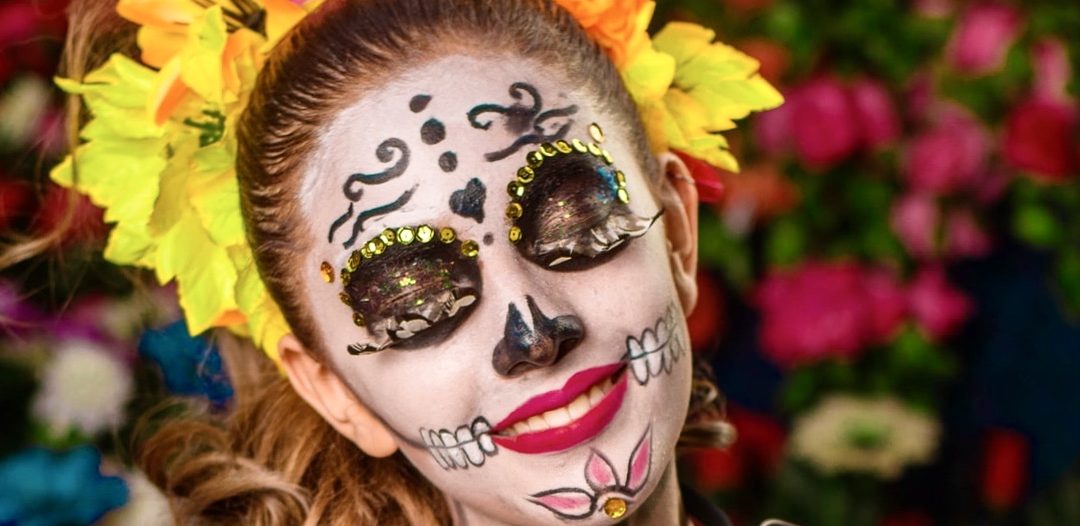The Mexican Festival of the Dead – El Dia de los Muertos – Jean Francis
One of my most memorable holidays has to be a visit to Mexico to take part in the The Mexican Festival of the dead – El Dia de los Muertos.
This festival is a sacred celebration that takes place on ‘All Saints Day,’ October 1st which is an important part of the Catholic Church calendar and ‘All Souls Day,’ November 2nd. This is when the veil between the two worlds is at its thinnest – a pagan belief when this world and the ‘Otherworld’ meets.
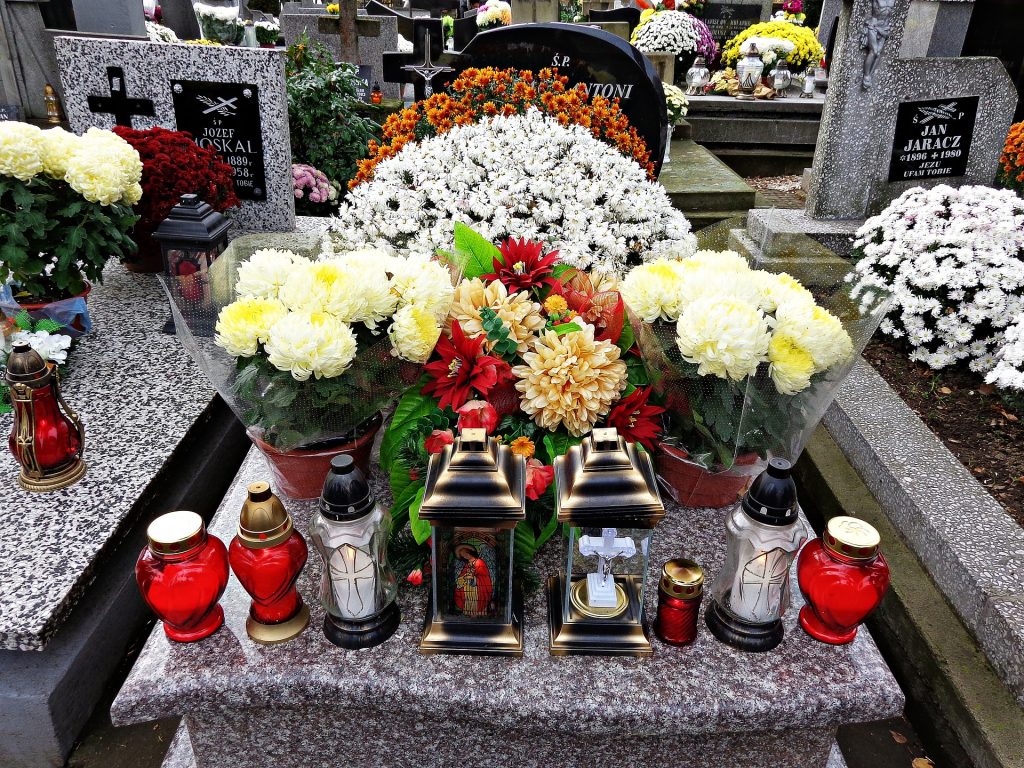 Day 1. The Festival is a national holiday when family, friends and the wider community gather to celebrate and welcome back the souls of loved ones who with divine permission return from the dead for this short time each year. This old tradition is celebrated in Mexico and in many other parts of the world. It is descended from pagan celebrations that the Catholic Church re-attributed to their saints. Children take time out of school and disguised as monsters, werewolves, vampires and extra-terrestrial beings take part in street parades.
Day 1. The Festival is a national holiday when family, friends and the wider community gather to celebrate and welcome back the souls of loved ones who with divine permission return from the dead for this short time each year. This old tradition is celebrated in Mexico and in many other parts of the world. It is descended from pagan celebrations that the Catholic Church re-attributed to their saints. Children take time out of school and disguised as monsters, werewolves, vampires and extra-terrestrial beings take part in street parades.
There is real warmth in the market place, as the entire town becomes alive with activity. Bright paper cut-outs hang from stalls full of everything scary; sugary skulls, skeletons, witches’ hats and broom sticks, ghosts, bats, scary masks, false teeth, skeletons, warty noses and flowers galore.
Alters appear in shops hotels, private homes and on the roadside, in fact pretty much everywhere; they are created in memory and to honour souls of the dearly departed. Creating such altars is an elaborate and time consuming custom. Brightly coloured swathes of fabric adorned with fruit, sweets and flowers; with lighted candles beside photographs of loved ones and a collection of their favourite personal belongings. Special altars in memory of deceased children are arranged on a lower level, with sweets, toys, lighted candles, flowers and always photographs.
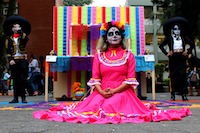
Day 2 morning: Our hotel in Oaxaca, complete with its bountiful altar, was only a short walk from The San Miguel Cemetery. Within the walls we discovered granite mausoleums, stone sculptures of angels, onyx vases, devotional effigies and humble graves with a simple wooden cross.
Entire families scurry about the graves in a buzz of activity; scrubbing and polishing the gravestones until they sparkled with not a grain of dust in sight or a leaf out of place. Flowers arrived by the lorry load; cock’s comb, chrysanthemums, roses, carnations, marguerites and an abundance of cempasuchitl, otherwise known as Aztec marigolds. Candles were carefully placed in readiness to be lit as darkness fell.
The walls of the cemetery were lined with tea-lights, one in each small cavity, ready to be illuminated at night. Children played, as artists on their knees create colourful sand-mats depicting the celebration. Wandering around amongst these busy people we found a great feeling of camaraderie in spite of not speaking the language.
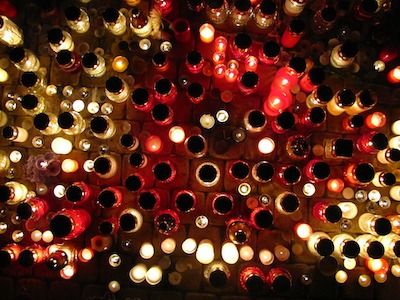
Day 2 evening: Vendors lined the street leading to the Cemetery. Spicy aromas filled the night air, eating and drinking being very much part of the celebration.
Food and delicacies were being prepared in abundance to feed all, including the returning souls. Chicken with chilli and chocolate sauce being a traditional favourite. Chilaquiles, Tacos al pastor, and delicious Elote (corn on the cob) served with chilli powder, lime, butter, cheese, mayonnaise and sour cream. Special bread baked and decorated to simulate bones and sometimes with a face peeping out from within the folds of crusty top. A supply of chilli flavoured chocolate is guaranteed and always a toast to absent friends.
The cemetery was lit, by surely a million candles flickering amongst the extravagantly adorned graves. Families gathered to say prayers or just sit quietly and remember. A brass band played and strolling musicians sang requested songs. A solitary guitarist played and sang a romantic ballad over a grave and an elderly woman sat hunched on another. Family groups picnicked but with reverence to those around them. As the evening progressed fire-crackers were abound, No doubt the revelries continued long after our departure to the welcome warmth of our hotel beds.
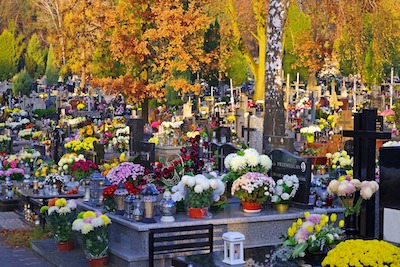
Day 3: We took the morning bus to The Teopitlan de Valle Cemetery in Zatotec village way out in the countryside where crowds were gathered all dressed in their Sunday best.
At midday deceased souls were welcomed into our midst with church bells ringing. Amongst the abundance of flowers families enjoyed their picnic as they listened to the music and remembered.
During the afternoon attention was drawn to Preciosa de Christ Church, a small pink building where men from the village gathered. We were curious but soon realised that we were the only women present; we slunk into a dark corner to bear witness but were encouraged to join in.
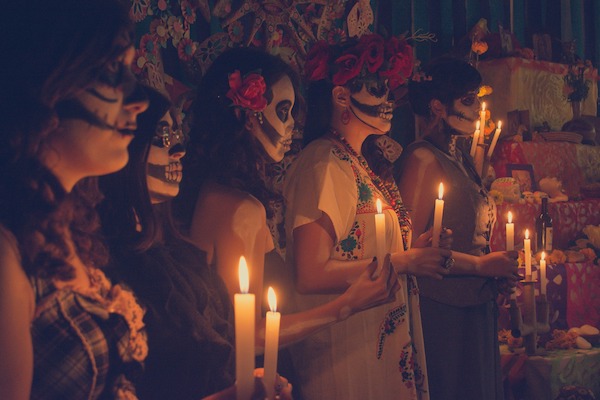 We were totally enthralled with this all-encompassing experience. As day light began
We were totally enthralled with this all-encompassing experience. As day light began
to fade we became aware that our bus back to Oaxaca was due, it was an intrepid wait as the bus did not arrive as time-tabled. We were standing in the middle of nowhere at night waiting and hoping. Eventually the welcome vehicle presented its self and feeling highly relieved we jumped aboard.
Next morning a jovial carnival procession wove its way through Oaxaca, which included marching bands, fancy dress and women wearing traditional Spanish costume carrying baskets high above their heads full of sweets, which were thrown generously into the gathered crowds.
The Festival intrigues many visitors and sometimes shocks others.
A typical epitaph translated: ‘See you later.’
Find many free resources on our site about how you can prepare for end-of-life, from conversations in our Tea Rooms, tips about legal requirements, funeral planning, memorials and celebrations. Or take a look in our shop. A portion of proceeds from sales are donated to plant trees with Ancient and Sacred Trees and also Sussex Green Living.

